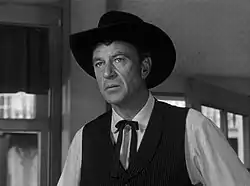Everyman
The everyman is a stock character in fiction. An ordinary and humble character,[3][4] the everyman is generally a protagonist whose benign conduct fosters the audience's wide identification with him.

Origin

The term everyman traces to an English morality play from the early 1500s: The Summoning of Everyman.[4] The play's protagonist is an allegorical figure representing an ordinary human faced with imminent death; according to literature scholar Harry Keyishian he is portrayed as "prosperous, gregarious, [and] attractive".[6] Everyman is the only human character in the play; the others are embodied ideas such as Fellowship, who "symbolizes the transience and limitations of human friendship."[6]
The use of the term everyman to refer generically to a portrayal of an ordinary or typical human being dates to the early 20th century.[7] The term everywoman originates in the same period, having been used by George Bernard Shaw to describe the character Ann Whitefield in his play Man and Superman.[8]
Narrative uses
An everyman is crafted so that most audience members can readily situate themselves in his shoes. Although the everyman may face obstacles and adversities that a hero might, archetypal heroes react rapidly and vigorously by manifest traits, whereas an everyman typically avoids engagement or reacts ambivalently, until the situation, growing dire, demands effective reaction to avert disaster. Such a round, dynamic character—that is, a character showing depth and development—is then generally a protagonist.[9]
Or if lacking depth and development—thus a flat, static character—the everyman is a secondary character. Especially in literature, there is often a narrator, as the written medium enables extensive explication of, for example, backstory, tangents, physical details, and mental content. An everyman narrator may draw little notice, whether by other characters or sometimes even by the reader, since the narration emerges, then, from the story world. And if neutral or relatable enough, the narrating everyman may even, breaking the fourth wall directly address the audience.
See also
| Look up everyman in Wiktionary, the free dictionary. |
- Average Joe – wholly average person
- Commoner – person neither nobility, royalty, nor priesthood
- Elckerlijc - Dutch medieval morality play
- Everyman's right – freedom to roam
- Kafkaesque – everyman being overwhelmed by vast, dehumanizing social labyrinth
- Man on the Bondi tram – hypothetical reasonable Australian
- Person having ordinary skill in the art
- John Q. Public – generic, hypothetical "common man"
- Reasonable person – term helping a jury interpret a law's wording
- Straight man
- T.C. Mits – acronym for "the celebrated man in the street"
- The man on the Clapham omnibus – hypothetical reasonable person
- Zé Povinho – Portuguese everyman
References
- King, Susan (April 29, 2001). "Back When Decency Was Glamorous". Los Angeles Times. Retrieved April 12, 2020.
- Murrin, John M.; Johnson, Paul E.; McPherson, James M.; Fahs, Alice; Gerstle, Gary (2011). Liberty, Equality, Power: A History of the American People, Volume 2: Since 1863. Cengage Learning. p. 764. ISBN 9781133171867.
- "WordNet Search - 3.0". Princeton University. Retrieved April 11, 2020.
- "Everyman - Definition". Merriam-Webster. Retrieved April 11, 2020.
- Pickett, Howard (August 2012). "Theatrical Samaritans: Performing Others in Luke 10:25-37". The Journal of Scriptural Reasoning. 11 (1). Retrieved April 14, 2020.
- Harry Keyishian, "Review of Douglas Morse, dir.,The Summoning of Everyman (Grandfather Films, 2007)", Shakespeare Bulletin (Johns Hopkins U P), 2008 Fall;26(3):45–48.
- ""Everyman, n."". Oxford English Dictionary. Retrieved October 26, 2021.
- ""Everywoman, n."". Oxford English Dictionary. Retrieved October 26, 2021.
- "Common Character Archetypes" (PDF). University of Texas at Austin College of Liberal Arts. University of Texas at Austin.